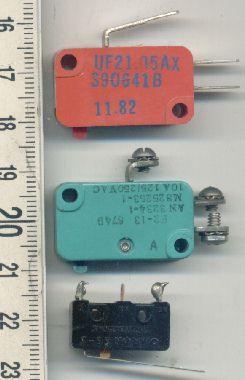Need some feedback/info for how to detect if a ball valve like the one below, is open or closed?
Are the valve and pipework non magnetic?
How reliable does it need to be? If the reading is wrong will the reactor blow up, or is it just an annoyance?
Microswitches:

mikb55:
Are the valve and pipework non magnetic?How reliable does it need to be? If the reading is wrong will the reactor blow up, or is it just an annoyance?
My home-made nuclear power plant will have a full melt-down if the reading is wrong... just kidding. No damage will occur if the reading is wrong.
The pipes are copper - non-magnetic, but the valve is magnetic (but I'm not 100% sure since it is located at my cabin far far away). I can check this the next time I'm at my cabin.
One problem to consider is that the valve shall be used by humans and the sensor must be of a type and mounted so that it's function is not "damaged" by handling the valve.
jremington:
Microswitches:
I can try to use one (got several). But I suspect that a microswitch will make it difficult to use the valve.
A sturdy way to detect the lever, even in a humid environment and which is not in the way at any moment ? That might not be possible. Your insurance might be void if you try to add something.
Koepel:
A sturdy way to detect the lever, even in a humid environment and which is not in the way at any moment ? That might not be possible. Your insurance might be void if you try to add something.
A pressure sensor behind the valve would be a good way to read the status, but as you wrote, it may cause problem with the insurance.
Before I posted my question I was thinking of using either some sort of optical sensor or a hall sensor.
What do you want to know? Is a reassurance that the water was turned off by the last person there? I ask because I am wondering whether a water meter detecting flow would be sufficient.
Hello, I'm inclined to do it magnetically:
If we glue hard, (epoxy glue or similar), and in the correct position, (distances, angles etc), an A magnet and a
rele reed, the problem is solved.
I'll consider the magnet reed relay solution. Got reed relays but no small strong magnets.
But I suspect that a microswitch will make it difficult to use the valve.
Not if it is properly designed, like these commercially available ball valves with limit switches.
thehardwareman:
I'll consider the magnet reed relay solution. Got reed relays but no small strong magnets.
Strong magnets are definitely NOT needed for reed switches. I don't see how a reed relay could possibly help with your project. Just be sure the N-S magnetic field is aligned with the metal reeds in the switch.
Paul
jremington:
Not if it is properly designed, like these commercially available ball valves with limit switches.
Hmm... this looks like "add on" sensor/switches, or?
For a prototype solution I would just tape a bar magnet to the underside of the handle and cover the whole assembly with a piece of heat shrink tubing, or perhaps wrap with self fusing butyl tape. From an ergonomic point of view the increase in diameter might actually make it easier to use.
Put the reed switch on top of the copper pipe. Check to see if the valve body magnetizes enough to cause false readings.
I would go with an optical or magnetic method with the most robust component on the handle.
It could be a reflective dot or a strong magnet. You can get them with a screw hole to fix them.
In industry an process lines, all the valves will have position indicators to feedback to SCADA systems.
For simplicity and robustness, this will usually be microswitches in a failsafe configuration.
Basically, it's a simple problem to solve.
I forgot to mention, that the sort of valve you are using come in all sorts of qualities if you use a magnetic solution.
The best quality will use brass bodies with stainless steel balls - the stainless can be magnetic or nonmagnetic according to quality.
Thanks for all input. I'm not in a hurry so I will test different solutions and update this thread.
BTW, the valve and pipes are already installed (years ago). There is a foam around the pipe so the clearing between the handle and the foam is not much. I'll take some pictures of the valves next time I'm at the cabin.
This topic was automatically closed 120 days after the last reply. New replies are no longer allowed.

